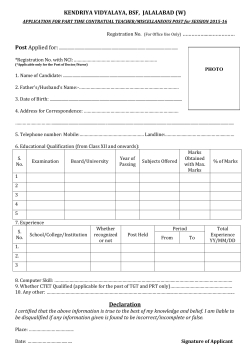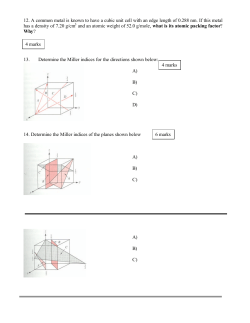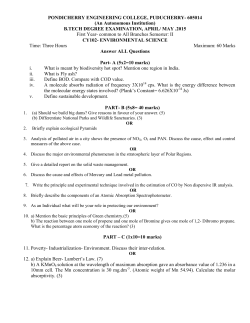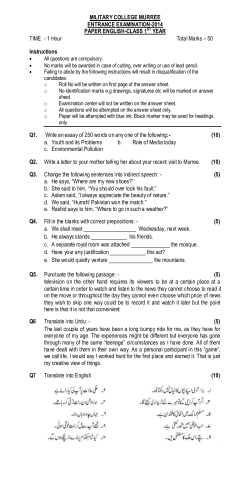
1244 - HSCDocs.org
STRATHFIELD GIRLS HIGH SCHOOL BIOLOGY TRIAL HIGHER SCHOOL CERTIFICATE EXAM 2005 Time Allowed: Three Hours + 5 minutes reading time Name: ………………………………… Teacher: ……………………………… STUDENT’S INSTRUCTIONS • • Answer all multiple choice questions on the Multiple Choice page. Answer all other questions on this exam paper. Section I: Part A: 15 Multiple Choice Questions (15 marks). Part B: Written Questions (60 marks). Section II: Option: Genetics – the Code Broken (25 marks) Total Marks: 100 EXAMINER’S INSTRUCTIONS All students to receive this examination paper (15 pages) and Multiple Choice page. Reading time: 5 Minutes Both papers are to be collected separately at the end of the exam and returned to the Science staff room. Thank you Part A – 15 marks. Allow about 25 minutes for this part. Answer all questions on the Multiple Choice page. Place an X in the correct space on the Multiple Choice answer sheet. 1. The horse has a diploid chromosome number of 64. The housefly has a haploid number of 6. Based on this information, which statement is correct? (A) Large animals always have more chromosomes than small animals. (B) The gametes of a housefly would contain 3 chromosomes. (C) The gametes of a horse would contain 32 chromosomes. (D) The body cells of a horse would contain 128 chromosomes. 2. The following is a family pedigree detailing the family members who have a widow’s peak hairline. It is a recessive trait. I Key : 1 2 Female II Male 1 III 1 2 3 2 3 4 4 Trait demonstrated 5 6 ? IV What conclusions can be drawn from the pedigree? (B) Generation III All the offspring from Generation II were girls All the males have a widows peak (C) Offspring 5 is a carrier of the trait (D) Offspring 5 is a carrier of the trait (A) Generation IV All offspring of 5 & 6 would have a widows peak Some offspring of 5 & 6 could have a widows peak All offspring of 5 & 6 would have a widows peak Some offspring of 5 & 6 could have a widows peak 3. Which person in the list helped to determine the structure of DNA? (A) Francis Crick. (B) Charles Darwin. (C) Gregor Mendel. (D) Ronald Ross. 4. Which type of cell is responsible for the production of antibodies? (A) T cells. (B) T memory cells. (C) Plasma cells. (D) Macrophages. 5. The theory of evolution is supported by evidence such as the existence of transitional fossils. An example used is the fossil of Archaeopteryx lithographica shown alongside. Which of the following statements best supports the hypothesis that Archaeopteryx lithographica is a transitional fossil? (A) Archaeopteryx was about the size of a large raven but had a much longer tail. (B) Archaeopteryx has features similar to a bird including feathers, but also has reptilian features such as small teeth and a long bony tail. (C) You can see that Archaeopteryx evolved from birds. (D) All birds are believed to have evolved from reptiles. 6. What is an example of information that might be gathered in an epidemiological study? (A) People who work in clubs have a higher than average incidence of lung cancer. (B) Cigarette smoke contains thousands of chemicals capable of causing cancer. (C) Mice injected with LDL (low density lipoproteins) show a 70% reduction in the number of fatty plaques in the heart arteries. (D) In a study of 30 people, a gene mutation has been linked to heavy drinking. 7. What was Louis Pasteur’s major contribution in the history of humanity’s understanding of disease? (A) He developed a series of laboratory procedures by which a causative pathogen could be identified. (B) He invented a staining technique which could be used to classify bacteria. (C) He discovered antibodies in the blood which could be switched on to a particular pathogen. (D) He performed an experiment which proved a direct link between decay and the presence of airborne microbes. 8. When a patient receives an organ transplant, it is common for doctors to suppress the immune response. Why is this done? (A) The immune response helps the new organ to become stronger and healthier. (B) The patient’s body works better with a suppressed immune response. (C) The new organ will work better with a suppressed immune response. (D) It prevents rejection of the new organ. 9. A pathogen can best be defined as (A) The visible effects of a disease. (B) The means by which a disease is contracted. (C) The area of the body that is most affected by disease. (D) Any organism capable of causing disease. 10. What is the reason that antibiotics are useful in the management of some infectious diseases? (A) Antibiotics stimulate the immune system to fight the infection (B) Some pathogens, such as viruses, are not affected by antibiotics (C) Antibiotics prevent the entry of pathogens into the body (D) Antibiotics prevent the growth of bacteria and fungi 11. Which would be the most important characteristics of a respiratory surface in animals? (A) large surface area and moist surface. (B) small surface area and dry surface. (C) small surface area and moist surface. (D) dry surface and pores to allow oxygen in and carbon dioxide out. 12. Which of the following correctly states the material carried by phloem and xylem vessels. (A) Phloem carries water and minerals while xylem carries the products of photosynthesis. (B) Phloem carries the products of photosynthesis while xylem carries water and minerals. (C) Phloem carries water only while xylem carries the products of photosynthesis. (D) Phloem carries the products of photosynthesis while xylem carries water only. 13. It is possible to distinguish between the saliva of a human and that of a dog by a simple test: Human saliva is mixed with starch solution and incubated at 37oC for 20 minutes. Iodine solution is then added, and the mixture remains yellow-brown. When dog saliva is treated the same way, the mixture becomes blue-black. What is the best explanation for the difference? (A) (B) (C) (D) Dogs and humans have different diets. Dog saliva lacks an enzyme present in human saliva. Dog saliva needs to be incubated at a higher temperature then 37oC. Dog saliva needs to be incubated for longer than 20 minutes. 14. A student on a field study at Bicentennial Park noticed salt crystals on the backs of leaves of mangrove trees in a river mudflat. What is the most likely explanation for the presence of these salt crystals? (A) Salt water has sprayed onto the leaf surface, and the water has evaporated. (B) Transpiration has brought salt water to the leaves because the plant cannot tolerate salt. (C) Active transport of salt out of leaves keeps salt levels in the plant low. (D) Active transport in root epidermal cells prevents the entry of salt into the plant. 15. Which of the following statements applies most accurately to temperature regulation in plants? (A) Plants have no control over their temperature. (B) Transpiration and movement of their leaves can prevent overheating in some plant species. (C) The temperature of plants is always exactly the same as that of the external environment. (D) Plants can stand much higher temperatures than animals. Part B – 60 marks. Allow about 1 hour and 40 minutes for this part Answer the questions in the spaces provided. Marks 16. (5 marks) There has been discussion about the effectiveness of vaccination. Supporters can show that death rates from infectious disease have been declining since vaccination began. Their opponents claim that this decline has been caused by increased personal and public hygiene, not vaccination. Using ONE of smallpox, diphtheria or polio, evaluate the effectiveness of a vaccination program. 5 ……………………………………………………………………………………….............………......................................… ……………………………………………………………………………………….............………......................................… ……………………………………………………………………………………….............………......................................… ……………………………………………………………………………………….............………......................................… ……………………………………………………………………………………….............………......................................… ……………………………………………………………………………………….............………......................................… ……………………………………………………………………………………….............………......................................… ……………………………………………………………………………………….............………......................................… ……………………………………………………………………………………….............………......................................… ……………………………………………………………………………………….............………......................................… ……………………………………………………………………………………….............………......................................… ……………………………………………………………………………………….............………......................................… 17. (4 marks) (a) Distinguish between the terms “infectious disease” and “non-infectious disease”. 1 ……………………………………………………………………………………….............………......................................… ……………………………………………………………………………………….............………......................................… (b) For a named infectious disease, state the cause, how it is transmitted and describe the symptoms. ……………………………………………………………………………………….............………......................................… ……………………………………………………………………………………….............………......................................… ……………………………………………………………………………………….............………......................................… ……………………………………………………………………………………….............………......................................… ……………………………………………………………………………………….............………......................................… ……………………………………………………………………………………….............………......................................… ……………………………………………………………………………………….............………......................................… ……………………………………………………………………………………….............………......................................… 3 18. (4 marks) Discuss the role of quarantine in preventing the spread of disease in Australia. 4 ……………………………………………………………………………………….............………......................................… ……………………………………………………………………………………….............………......................................… ……………………………………………………………………………………….............………......................................… ……………………………………………………………………………………….............………......................................… ……………………………………………………………………………………….............………......................................… ……………………………………………………………………………………….............………......................................… ……………………………………………………………………………………….............………......................................… ……………………………………………………………………………………….............………......................................… ……………………………………………………………………………………….............………......................................… 19. (6 marks) (a) Describe an experimental procedure you undertook to identify microbes in food or in water. 4 ……………………………………………………………………………………….............………......................................… ……………………………………………………………………………………….............………......................................… ……………………………………………………………………………………….............………......................................… ……………………………………………………………………………………….............………......................................… ……………………………………………………………………………………….............………......................................… ……………………………………………………………………………………….............………......................................… ……………………………………………………………………………………….............………......................................… ……………………………………………………………………………………….............………......................................… ……………………………………………………………………………………….............………......................................… …………………………………………………………………………………….............………......................................… ……………………………………………………………………………………….............………......................................… (b) Explain why cleanliness in food or in water assists in the control of disease. ……………………………………………………………………………………….............………......................................… ……………………………………………………………………………………….............………......................................… ……………………………………………………………………………………….............………......................................… ……………………………………………………………………………………….............………......................................… ……………………………………………………………………………………….............………......................................… 2 Question 20. (6 marks) The diagram shows the structure of a nephron in a human kidney. The table below shows an analysis of samples taken from three points along the nephron. Substance Water Proteins Urea Glucose Concentration (%) At F At C At A 91.50 99.00 96.00 8.00 0.00 0.00 0.04 0.04 2.80 0.15 0.00 0.00 (a) Explain how these changes occur, referring to the diagram and naming the process involved in each case: 3 (i) the decrease in glucose concentration between F and C. .……………………………………………………………….................... .……………………………………………………………….................... .……………………………………………………………….................... (ii) the decrease in protein concentration between F and C. ……………………………………………………………………………………….............………......................................… ……………………………………………………………………………………….............………......................................… (iii) the increase in urea concentration between C and A. ……………………………………………………………………………………….............………......................................… ……………………………………………………………………………………….............………......................................… (b) If the water concentration in the blood fell too low, explain how the body’s response would increase the water concentration. ……………………………………………………………………………………….............………......................................… ……………………………………………………………………………………….............………......................................… ……………………………………………………………………………………….............………......................................… ……………………………………………………………………………………….............………......................................… ……………………………………………………………………………………….............………......................................… ……………………………………………………………………………………….............………......................................… ……………………………………………………………………………………….............………......................................… ……………………………………………………………………………………….............………......................................… 3 Question 21. (2 marks) 2 A student set up the equipment in the diagram below to investigate the enzyme catalase in potato, which increases the rate of decomposition of hydrogen peroxide to water and oxygen. No reaction Froth = Oxygen produced froth hydrogen peroxide cube of potato (containing catalase) pH level pH 2 4 acid 6 8 10 12 14 base What conclusion would the student draw from this experiment? ……………………………………………………………………………………….............………......................................… ……………………………………………………………………………………….............………......................................… ……………………………………………………………………………………….............………......................................… ……………………………………………………………………………………….............………......................................… Question 22. (4 marks) (a) A lot of work has also been done on the development of artificial blood. Explain why there is a need 2 for artificial blood. ……………………………………………………………………………………….............………......................................… ……………………………………………………………………………………….............………......................................… ……………………………………………………………………………………….............………......................................… ……………………………………………………………………………………….............………......................................… ……………………………………………………………………………………….............………......................................… (b) Explain the problems researchers would encounter in developing artificial blood. ……………………………………………………………………………………….............………......................................… ……………………………………………………………………………………….............………......................................… ……………………………………………………………………………………….............………......................................… ……………………………………………………………………………………….............………......................................… 2 Question 23. (4 marks) The blood is one of the most important tissues in the body. (a) Outline TWO reasons why blood is so important. 1 ……………………………………………………………………………………….............………......................................… ……………………………………………………………………………………….............………......................................… (b) An important recent procedure has been the development of techniques to measure the concentration of gases in blood. Outline a way in which one named gas is measured, and explain when there would be a need to measure the concentration of this gas. 3 ……………………………………………………………………………………….............………......................................… ……………………………………………………………………………………….............………......................................… ……………………………………………………………………………………….............………......................................… ……………………………………………………………………………………….............………......................................… ……………………………………………………………………………………….............………......................................… ……………………………………………………………………………………….............………......................................… ……………………………………………………………………………………….............………......................................… Question 24. (4 marks) Describe the responses of a named Australian animal living in a harsh environment in order to maintain homeostasis and explain why these responses are necessary. ……………………………………………………………………………………….............………......................................… ……………………………………………………………………………………….............………......................................… ……………………………………………………………………………………….............………......................................… ……………………………………………………………………………………….............………......................................… ……………………………………………………………………………………….............………......................................… ……………………………………………………………………………………….............………......................................… ……………………………………………………………………………………….............………......................................… ……………………………………………………………………………………….............………......................................… ……………………………………………………………………………………….............………......................................… ……………………………………………………………………………………….............………......................................… ……………………………………………………………………………………….............………......................................… ……………………………………………………………………………………….............………......................................… ……………………………………………………………………………………….............………......................................… 4 Question 25. (2 Marks) Using suitable examples, explain why co-dominance does not produce simple Mendelian ratios. 2 ……………………………………………………………………………………….............………......................................… ……………………………………………………………………………………….............………......................................… ……………………………………………………………………………………….............………......................................… ……………………………………………………………………………………….............………......................................… ……………………………………………………………………………………….............………......................................… Question 26. (4 marks) Compare and contrast the processes used to clone animals and plants. 4 ……………………………………………………………………………………….............………......................................… ……………………………………………………………………………………….............………......................................… ……………………………………………………………………………………….............………......................................… ……………………………………………………………………………………….............………......................................… ……………………………………………………………………………………….............………......................................… ……………………………………………………………………………………….............………......................................… ……………………………………………………………………………………….............………......................................… ……………………………………………………………………………………….............………......................................… ……………………………………………………………………………………….............………......................................… ……………………………………………………………………………………….............………......................................… Question 27. (4 marks) Using an appropriate example, explain how comparative anatomy provides evidence for evolution. ……………………………………………………………………………………….............………......................................… ……………………………………………………………………………………….............………......................................… ……………………………………………………………………………………….............………......................................… ……………………………………………………………………………………….............………......................................… ……………………………………………………………………………………….............………......................................… ……………………………………………………………………………………….............………......................................… ……………………………………………………………………………………….............………......................................… ……………………………………………………………………………………….............………......................................… ……………………………………………………………………………………….............………......................................… ……………………………………………………………………………………….............………......................................… 4 Question 28. (5 marks) Consider this family of cats with polydactyly, a condition in which they have an extra toe on their hind feet: Generation I – A female with polydactyly (A) mates with a normal male (B). Generation II – Three offspring result from the mating in generation I : a normal female (C), a normal male (D) and a normal female (E). Generation III – The female (C) mates with a male with polydactyly (F), and they have two female offspring (G and H), both with polydactyly. The male (D) has no offspring. The female (E) mates with a normal male (I) and they have two male offspring (J and K) both with polydactyly. (a) Construct a family pedigree for the cat family described, using the symbols given in the key: 2 Key Normal male cat Normal female cat Male cat with polydactyly Female cat with polydactyly Relationship between cats (b) Is the allele for polydactyly dominant or recessive? Explain your answer. 1 ……………………………………………………………………………………….............………......................................… ……………………………………………………………………………………….............………......................................… (c) Give all possible genotypes for individuals E and B. Justify your answer. ……………………………………………………………………………………….............………......................................… ……………………………………………………………………………………….............………......................................… ……………………………………………………………………………………….............………......................................… ……………………………………………………………………………………….............………......................................… 2 Question 29. (6 marks) “Current genetic engineering processes have the potential to alter the path of evolution.” Discuss this statement using one genetic engineering process to support your answer. ……………………………………………………………………………………….............………......................................… ……………………………………………………………………………………….............………......................................… ……………………………………………………………………………………….............………......................................… ……………………………………………………………………………………….............………......................................… ……………………………………………………………………………………….............………......................................… ……………………………………………………………………………………….............………......................................… ……………………………………………………………………………………….............………......................................… ……………………………………………………………………………………….............………......................................… ……………………………………………………………………………………….............………......................................… ……………………………………………………………………………………….............………......................................… ……………………………………………………………………………………….............………......................................… ……………………………………………………………………………………….............………......................................… ……………………………………………………………………………………….............………......................................… ……………………………………………………………………………………….............………......................................… 6 OPTION: GENETICS – THE CODE BROKEN? (25 marks) (a) Some genetically determined features have a distribution that can be represented by the graph below. (i) 3 What term is used to describe inheritance that shows this distribution? ……………………………………………………………………………………….............………......................................… (ii) Explain how this distribution pattern occurs in this form of inheritance. ……………………………………………………………………………………….............………......................................… ……………………………………………………………………………………….............………......................................… ……………………………………………………………………………………….............………......................................… ……………………………………………………………………………………….............………......................................… ……………………………………………………………………………………….............………......................................… ……………………………………………………………………………………….............………......................................… (b) A gardener took pollen from a pure-breeding pea plant with tall stem and white flowers and used it to pollinate a pure breeding dwarf pea plant with purple flowers. She found that all the offspring (F1) were tall plants with purple flowers. (i) Which characters are dominant? 1 ……………………………………………………………………………………….............………......................................… (ii) Using appropriate symbols, what would be the ratio of genotypes in the gametes produced by the F1 plants? 2 ……………………………………………………………………………………….............………......................................… (iii) Using a Punnett square, determine the ratio of phenotypes in the offspring produced if a plant which is homozygous for tall stem and white flowers is crossed with a plant which is heterozygous for both stem height and flower colour. 4 (c) Describe how gene therapy is used to manage a named disease. 4 ……………………………………………………………………………………….............………......................................… ……………………………………………………………………………………….............………......................................… ……………………………………………………………………………………….............………......................................… ……………………………………………………………………………………….............………......................................… ……………………………………………………………………………………….............………......................................… ……………………………………………………………………………………….............………......................................… ……………………………………………………………………………………….............………......................................… ……………………………………………………………………………………….............………......................................… ……………………………………………………………………………………….............………......... (d) During your study of this option you have constructed a model of DNA. (i) Outline the method you used to construct this model. 3 ……………………………………………………………………………………….............………......................................… ……………………………………………………………………………………….............………......................................… ……………………………………………………………………………………….............………......................................… ……………………………………………………………………………………….............………......................................… ……………………………………………………………………………………….............………......................................… ……………………………………………………………………………………….............………......................................… ……………………………………………………………………………………….............………......................................… (ii) Suggest a reason why we use models in Biology. 1 ……………………………………………………………………………………….............………......................................… ……………………………………………………………………………………….............………......................................… …………………………………………………………………………………….............………......................................… (iii) Draw a labelled diagram of your results. 2 (e) With the aid of labelled diagrams, outline the role of DNA, mRNA, tRNA and ribosomes in the production of a polypeptide. ………………………………………………………………… …………………….............………......................................… ………………………………………………………………… …………………….............………......................................… ………………………………………………………………… …………………….............………......................................… ………………………………………………………………… …………………….............………......................................… ………………………………………………………………… …………………….............………......................................… ………………………………………………………………… …………………….............………......................................… ………………………………………………………………… …………………….............………......................................… ………………………………………………………………… …………………….............………......................................… ………………………………………………………………… …………………….............………......................................… 5
© Copyright 2025









